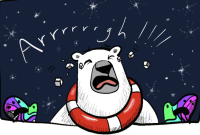This four-part series, Beyond the Climate Crisis Gloom, explores why as we adults navigate the harsh realities of the climate crisis and do the hard work of creating change, we must also build an environment of hope and opportunity for ourselves and our children that sets our sights on a brighter future. The first instalment focused on why our children need more positive messages and how we can start to provide those.
This second instalment zeros in on how kids instinctively just get what is good for the planet and how climate action can be fun and uplifting for us all.
Leave it to a pyjama-wearing eight-year-old to spark an epiphany in her father about climate action. When my daughter spontaneously hugged an electric car on the morning of our test drive, she got my gears turning. She laid her little body on the car’s hood with outstretched arms and with one ear pressed against its cool, smooth metal she whispered, “It has a heartbeat.”
The fact that the car intuitively appealed to her: quiet, cool to the touch, not “stinky” and “zoomy” smooth to drive in — led her to treat the machine like a family pet. What struck me was that we should take more cues from young children because they naturally understand what is healthier for them and the planet.
If kids understand at their core what is good for the planet and also live in the moment, seemingly driven by the singular focus of having fun, might climate action and fun go hand-in-hand for them? And might this synergy enable parents and children to move beyond climate anxiety together?
Electric cars are becoming commonplace and kids are noticing and applauding them. Anti-EV myths, aimed at slowing the decline of fossil fuel use, have long been dispelled. For example, kids know that modern batteries now have long lives and their materials can be recycled into new batteries down the line.
And, just like my EV-hugging daughter, they’re able to sense when transportation solutions are good for the planet just by interacting with them.
Dodging e-scooters, e-unicycles, e-skateboards and e-bikes that travel in near e-silence (often piloted by tweens, teens and the young at heart) has become commonplace in urban centres. We veteran experts of wheeled locomotion often scoff at these electron-powered contraptions and their youthful operators. We perceive them as dangerous, or at the very least, annoying, careening around on the roads that we thought our cars owned.
Yet ask a child and they will tell you these vehicles are good for the planet because they use far less energy, take up less space, require fewer materials to produce, don’t burn fossil fuels … and even more importantly — they are fun!
Less obvious to our aging eyes is the advent of electric school buses from the likes of Quebec’s Lion Electric. While many of us adult taxpayers question the cost of replacing diesel buses, kids will tell you that e-buses reduce carbon emissions, save their lungs from exhaust fumes and are quiet enough to hear The Weeknd’s tunes on their phones as they bounce along on the ride home.
And how about e-planes? (Resist the urge to scoff again.) A year-and-a-half ago, Harbour Air Seaplanes’ CEO Greg McDougall piloted the first test flight of an electric seaplane. Successfully becoming the first pilot of a commercially-capable e-plane, McDougall arguably ushered in the electric aviation age.
As he climbed out of his neon-yellow, zero-emissions, low-maintenance flying e-machine, it was the reactions of the cheering children there that struck me. The kids were buzzing; they instinctively understood why a plane not belching smelly exhaust was good for the planet — and how cool it was.
When a journalist asked if the public would ever embrace e-flight as being safe, then CEO of the provider of the plane’s electric motor, Roei Ganzarski, then with MagniX, replied, “See these little kids? It’s not about you, it’s about them.”
He went on to explain that the children of today, growing up in an era of electric cars and climate heroes like Greta Thunberg, won’t hesitate as adults to fly electric — in fact, they will demand clean transportation options at every turn.
Kids just get climate action.
Last December, The Lancet published the first large-scale global study of climate anxiety in children, finding that “more than 50 per cent reported each of the following emotions: sad, anxious, angry, powerless, helpless and guilty. More than 45 per cent of respondents said their feelings about climate change negatively affected their daily life and functioning … 75 per cent said that they think the future is frightening and 83 per cent said that they think people have failed to take care of the planet.”
We have all watched our children withdraw when they are afraid. Learning to swim without some coaching, encouragement, and maybe even a floatie to hold onto is sure to lead to a child fearful of the water and one who is bound to miss out on the future fun that water play enables. We parents of young children must share with them climate action success stories to help cultivate hope and a sense of opportunity — lifting them above the waves of climate anxiety.
There are many brilliant humans working to electrify all modes of transportation that are throwing us life rings as we swim against the current and try to carry our children above the waves. Why not grab onto those life rings and use them to reframe the climate crisis for our kids? Let’s lead the way for our children — do a little jumping up and down of our own — to celebrate those who are addressing climate action.
The more we celebrate climate change progress, the more we can ignite joy and hope into ourselves and into our children. That joy and hope are the very fuel of our future. Kids get it — so can we.
The third instalment, Kindness and Science will Heal the Planet, will focus on how B.C. provincial health officer Dr. Bonnie Henry's words about kindness, along with advances in science, are sure to be at the core of how today’s children will help repair the planet.
Paul Shore is an award-winning author and technology consultant, who has worked in the worlds of software, semiconductors, health care, and the Olympic Games. His current writing project is a graphic novel series for children in collaboration with co-author Deborah Katz and illustrator Prashant Miranda called Planet Hero Kids: I Can Hear Your Heart Beep.






Comments